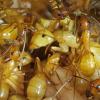I promise I'm not trolling or trying to stir the pot. I would just like to hear the reasons people may or may not do this.
In my case I have a captured colony that I found in an old tree cookie. however in the course of my job in taking care of a camp property I almost all the time am removing debris or moving things and seeing/disturbing colonies. Termites too! It's just now I know more bout ants.
I figured it was better in this instance to capture the colony and use it for education than to destroy it.
To demonstrate how often this happens, just yesterday I went to pick up a 1" x 4" x 24" board that was laying next to the camp driveway and found a Camponotus castaneus colony I put the board back but it really can't stay there and I went to move a damn traffic cone and found another Camponotus chromaiodes colony. Again eventually I have to move the cone (I don't want another chromaiodes colony anyhow) this doesn't count all the smaller ants that I have no idea what they are and termites too!
I personally wouldn't go looking for a colony just to remove it.
Surely in instances like these it's better to collect it than destroy it? Just some thoughts. Lets keep it civil

























